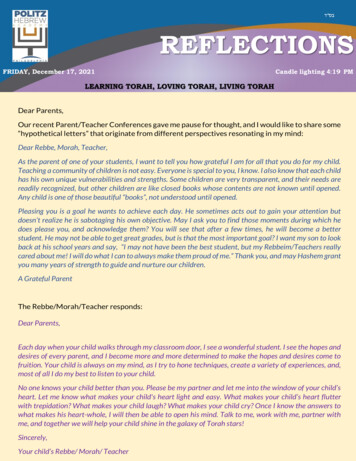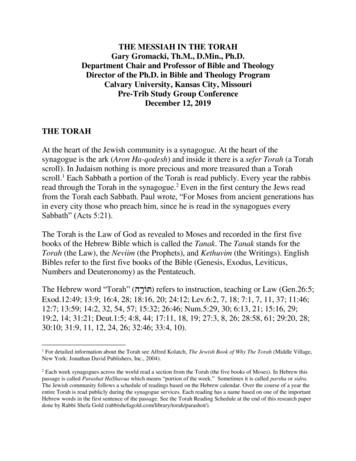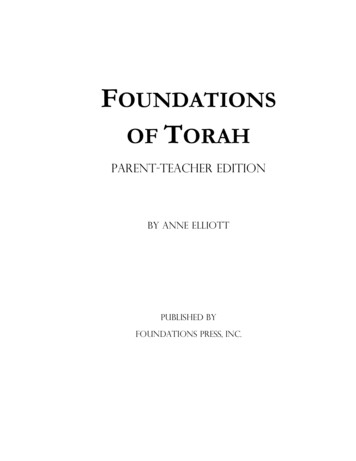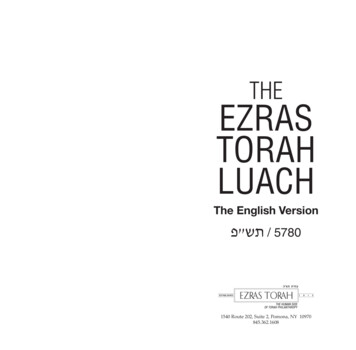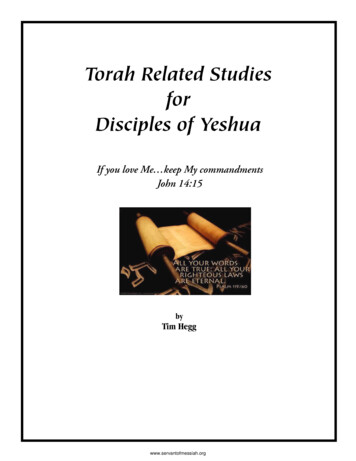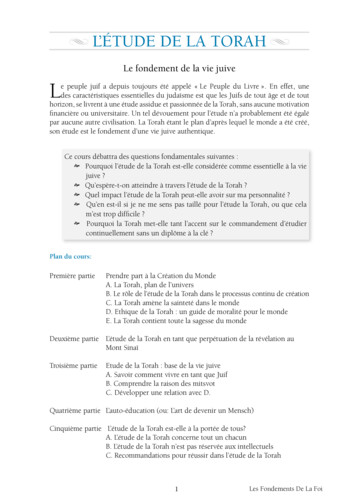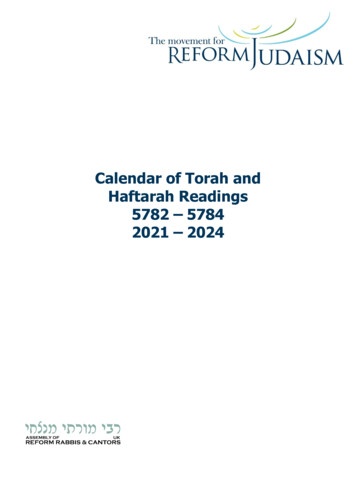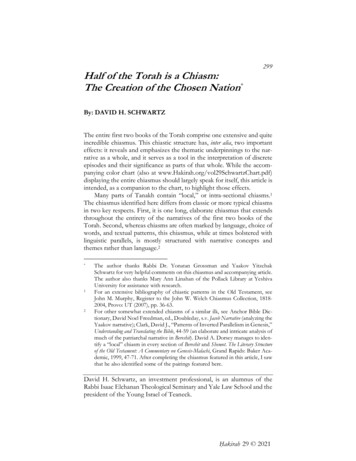
Transcription
Half of the Torah is a Chiasm:The Creation of the Chosen Nation*299By: DAVID H. SCHWARTZ*The entire first two books of the Torah comprise one extensive and quiteincredible chiasmus. This chiastic structure has, inter alia, two importanteffects: it reveals and emphasizes the thematic underpinnings to the narrative as a whole, and it serves as a tool in the interpretation of discreteepisodes and their significance as parts of that whole. While the accompanying color chart (also at www.Hakirah.org/vol29SchwartzChart.pdf)displaying the entire chiasmus should largely speak for itself, this article isintended, as a companion to the chart, to highlight those effects.Many parts of Tanakh contain “local,” or intra-sectional chiasms.1The chiasmus identified here differs from classic or more typical chiasmsin two key respects. First, it is one long, elaborate chiasmus that extendsthroughout the entirety of the narratives of the first two books of theTorah. Second, whereas chiasms are often marked by language, choice ofwords, and textual patterns, this chiasmus, while at times bolstered withlinguistic parallels, is mostly structured with narrative concepts andthemes rather than language.2*12The author thanks Rabbi Dr. Yonatan Grossman and Yaakov YitzchakSchwartz for very helpful comments on this chiasmus and accompanying article.The author also thanks Mary Ann Linahan of the Pollack Library at YeshivaUniversity for assistance with research.For an extensive bibliography of chiastic patterns in the Old Testament, seeJohn M. Murphy, Register to the John W. Welch Chiasmus Collection, 18182004, Provo: UT (2007), pp. 36-63.For other somewhat extended chiasms of a similar ilk, see Anchor Bible Dictionary, David Noel Freedman, ed., Doubleday, s.v. Jacob Narrative (analyzing theYaakov narrative); Clark, David J., “Patterns of Inverted Parallelism in Genesis,”Understanding and Translating the Bible, 44-59 (an elaborate and intricate analysis ofmuch of the patriarchal narrative in Bereshit). David A. Dorsey manages to identify a “local” chiasm in every section of Bereshit and Shemot. The Literary Structureof the Old Testament: A Commentary on Genesis-Malachi, Grand Rapids: Baker Academic, 1999, 47-71. After completing the chiasmus featured in this article, I sawthat he also identified some of the pairings featured here.David H. Schwartz, an investment professional, is an alumnus of theRabbi Isaac Elchanan Theological Seminary and Yale Law School and thepresident of the Young Israel of Teaneck.Ḥakirah 29 2021
300 : Ḥakirah, the Flatbush Journal of Jewish Law and ThoughtThe focus and theme of the narrative structure as a whole, as highlighted by the chiasmus, is the formation and subsequent teleology of theJewish nation, chosen by God to receive and observe the Torah and worship Him in His Sanctuary. The chiastic structure emphasizes the thematicbuild-up and focal points of this narrative in three ways. First, as is selfevident from the chiasmus itself and discussed further below, many of themirrored pairings throughout it substantively highlight this theme. Second, by definition it structurally highlights a center—and thus central—section of the story.3 Third, this chiasmus appears to “stretch” or “zoomin” as it approaches the center: the more one moves from the edge of thechiasmus toward the middle, the more granularly the associated narrativeand its details are represented therein.The first two books of the Torah, Bereshit and Shemot, may be described as a discrete narrative unit. Va-yikra, being, like much of the restof the Torah, more of a legal treatise than a chronological story, separatesthis unit from the rest of the Torah.4 Put simply, the story of Bereshit andShemot is the story of the creation of the Jewish people. Taken to one morelevel of granularity, the book of Bereshit is the story of God’s iterative process of choosing a particular family, the progenitors of His people. Shemot,in turn, is the story of that family becoming a nation and being endowedwith its raison d’être: the Torah and the bringing of God into this world.5As identified and developed by others,6 the recurring theme of Bereshitis one of choosing. God creates humanity, and distinguishes—the first3456See Elie Assis, “Chiasmus in Biblical Narrative: Rhetoric of Characterization,”Prooftexts 22:3 (Fall 2002), 273, citing those who suggest that the entire purposeof chiasmus is to focus the reader’s attention to the unit’s center. Other purposesadvanced for chiasmus include: serving as a mnemonic device; an artistic andaesthetic form; and to cohere, unify, and confine the boundaries of a literaryunit. Ibid.Relatedly, the chiasmus discussed herein is focused exclusively on the narrativecomponents of Bereshit and Shemot. Thus, the substantial portions of Shemot thatare legal, rather than narrative, in nature, do not play a role in the chiasmus,other than to the extent that they play a role in the narrative itself.See also Netziv, Ha‘amek Davar, Introduction to Shemot (explaining that the bookof Shemot is the natural sequel and complement to Bereshit, insofar as the receiving of the Torah by the chosen nation represents the telos and hence completionof the creation process); Ramban, Introduction to Commentary on Shemot (emphasizing the role of the Mishkan at the end, and climax, of Shemot as the completion of the redemption from the exile begun at the end of Bereshit and therestoration of the glory of the beginning of Bereshit).See, e.g., Menachem Leibtag, at h.org/breishit/toldot/toldots1.htm; https://tanach.org/breishit/vaychi/vaychis1.htm.
Half of the Torah is a Chiasm: The Creation of the Chosen Nation : 301choosing—humanity from the rest of creation, for better and for worse,in its ability to make moral choices: to be good or bad. Man’s capacity forevil (sin) is manifested on an individual scale in the story of Adam andEve, and on a global scale in that of the Flood. After the episode of theTower of Babel demonstrates that an utterly homogeneous, universalisthumanity is not the ideal approach for the redemption of man, the initialseeds of chosenness are sown in the foundation of heterogeneous nations.The inevitable next step is the choosing of Avraham as a chosen individual and in turn the father of a chosen family, with the identified ultimateobjective, from the outset, of developing into a chosen nation. We arethen met with two generational iterations of merit-based intrafamily culling and perfecting, of choosing and rejection, culminating with the life ofthe father of the Sons of Israel: Israel himself (Yaakov). Hence the storyof Yaakov’s life and family form the broader center of the chiasmus.The crystallization of a chosen family into a nation inevitably requiresan end to the pattern of intrafamily winnowing and choosing. Once identified and crystallized, the chosen nation remains chosen in its entirety,including all of its variegated parts. And like humanity as a whole, a nationitself cannot be internally homogeneous—not only in kind but even inrelation to moral worth and stature—and it does require leaders and leadership. Yet at a certain point that does not have to mean the selection ofsome at the expense of others, but rather a recognition of individual differences as part of a whole. This difficult adjustment is at the core of thestory of Yosef and his brothers, the next level of centrality and magnification of the chiasmus.Taken in the context of the family’s history until their time rather thanwith the benefit of hindsight, the brothers’ otherwise disturbing treatmentof Yosef becomes more understandable. Whether because of their perception of him as an ignoble, rejected brother of the Yishmael/Esaumold, or conversely as a rival, presumptuous or otherwise, to the exclusiveYitzḥak/Yaakov “chosen” berth, the brothers are playing with the deckthey believe they have been handed, in which their internecine rivalry is azero-sum game. Yosef, for his part, perhaps does not even know that hisexile is something other than a rejection in the tradition of Yishmael’s andEsau’s,7 and possibly does not learn otherwise at least until his spectacularrecovery and elevation from the depths of the dungeon to the power office in Pharaoh’s palace. Regardless of which of the many explanationsone accepts for Yosef’s extended harassment of his brothers when they7See, e.g. Yoel Bin Nun, “Why Didn’t Yosef Send (a Messenger) to His Father?”,Megadim 1:20-31 (1986).
302 : Ḥakirah, the Flatbush Journal of Jewish Law and Thoughtare first reunited in Egypt,8 their resulting acknowledgment of priorwrongs, peacemaking, and unification constitutes the transformation of aset of individual rivals into a cohesive family, one that is fit to become anation. Thus, in contrast to R19, where, in a final wave of choosing andrejection, only one brother is blessed by the patriarch, at the expense ofthe other, its parallel in R2 sees all the brothers blessed together, as prototypes of a future nation.10 As is the case throughout, their placement aspairs within the chiasmus serves to highlight this important contrast.But while they are blessed together, they do not, of course, all receivethe same blessing. Like any nation, albeit a fledgling one, the Jewish people is multifarious. And like any nation, they are in need of some form ofleadership. The ultimate destiny of the Jewish people is to live as a sovereign pious nation in its land, worshipping in its Sanctuary (per A1/A2)—and ruled by a king11 from its divinely designated royal line, the line ofYehuda. Thus, the final stage of the initial formation of the Jewish peoplenecessarily comprises the identification and inception of the royal line. Ashas been developed by many others,12 the story of Yosef and his brotherscontains within it the identification of Yehuda as the leader of the family,and, in turn, the future nation. From this standpoint, the hub of this storyline is the episode of Yehuda and Tamar, comprising as it does not onlythe turning point in the development of Yehuda’s character and his suitability for the leadership role13 but also the literal initial seeds of his royalline.8910111213See, e.g., Ramban, Bereshit 42:9; Abarbanel, Bereshit 41.All references are to labeled lines in the chiasmus, as indicated in the attached chart.Similarly, Yosef’s rejection of his brothers’ offer in P2 provides a contrast withthe fateful and far-reaching pact sealed in P1.I take no position on the long-debated question of whether monarchy is presented in Tanakh as the a priori ideal form of government for the Jewish people.See Sanhedrin 20b, Sifrei 156, and nearly all commentators on the tension betweenDevarim 17 and I Shmuel 8. Ideal or not, a Jewish monarchy is certainly not onlythe destined government of the Jewish people in Tanakh but is also a dominanttheme throughout Tanakh. That said, and regardless of the chiasmus identifiedin this essay, the strong thematic foreshadowing, as early as Bereshit, of the selection of Yehuda as the royal tribe does seem to emphasize the fundamental—if notideal—role that monarchy plays in the Jewish people’s destiny.See, e.g., Zvi Shimon, Hanhagat Yehuda Le-Umat Hanhagat Reuven, ; Yonatan Grossman, “TheStory of Yehuda and Tamar—The Contribution to the Narrative Cycle of Yosefand His Brothers,” at rs# ftnref10.See Shemot Rabbah, 30:16,19; Mekhilta de-Rabbi Ishmael, Masekhta Va-yehi Be-shalakh 5; Grossman, ibid.
Half of the Torah is a Chiasm: The Creation of the Chosen Nation : 303Hence, not only is the central story of the chiasmus this turning pointin his character, but the very center of this center (at line AM) is the conception of this royal line. Thus, while not usually thought of as a particularly foundational story, the chiasmus is telling us “loud and clear” thatthe Yehuda-Tamar story is indeed the focal point in the narrative of theformation of the Jewish people: the turning point or climax in the transition from chosen family to chosen nation is the conception of the royalline, of the leadership of that nation. While at first blush the centrality ofleadership in general and kingship in particular is not an obvious thematiccornerstone of the Torah, taken in the broader context of Tanakh—whichis clearly focused on the kingdom of Israel and its leaders, not to mentionthe ultimate advent of the messianic progeny of this royal line—this becomes much more understandable. Indeed, why shouldn’t the Torahproperly highlight and introduce the dominant theme of the broader Bibleof which it is a part?***Because of the difficulty of keeping track of such a large chiasmus (consisting of 77 “line items,” or 38 mirrored pairs and a central axis), theaccompanying chart is colored and shaded in order to facilitate identifyingthe counterpart of each narrative element. Rather than structuring thechart as one uninterrupted shape of increasingly indented rows, I havechosen to present it in eight sections—two sections of four “chapters”each—for two reasons. The first is quite pragmatic: it is simply a morepractical method of capturing the entire thing on one piece of paper. Second and more importantly, as mentioned above, it appears that the degreeof granularity to which the chiasmus is embedded in the narrative takes astep up as we move among its four “chapters”: from creation until thestory of Yaakov’s life; that story itself, namely the story of Israel, the fatherof the nation of Israel; the story of the shevatim, or Yosef and his brothers;and the story of Yehuda and Tamar culminating in the creation of theinitial seeds of the royal line of Yehuda. In other words, as we move fromone chapter to the next, the chiasmus is more comprehensively embeddedin not just the broad strokes of the narrative but in the finer detailstherein.1414In a similar vein, some of the parallels or pairs in the outer edges of the chiasmusare what I would call “secondary” rather than “primary” parallels. By this I meanthat their existence would not necessarily, in my view, be obvious or compellingenough on their own to justify the claim that this chiasmus is indeed embeddedin the narrative. Perhaps B1-B2 is such an example. Rather, once the chiasmuswith its “primary” parallels (which are primarily though not only concentrated
304 : Ḥakirah, the Flatbush Journal of Jewish Law and ThoughtRelatedly, I will share that the aforementioned phenomenon is directly connected to my discovery of the chiasmus itself. I began by noticing the much more prominent—precisely because it is much more granular—chiasmus embedded in parshat Va-yeshev. Given its strong, almostundeniable salience, it then served as an anchor as I searched for its continuation beyond—i.e., both before and after—Va-yeshev and to includeall of Yaakov’s life story. Reassured by what this uncovered, I then proceeded to explore just how far this pattern really extends and where wereits outer boundaries. This in turn is what led me to the discovery of thefull extent of the chiasmus—reinforced from a Bayesian perspective notonly by the continued waves of parallel mirrored pairs but also by theirconsistency with the core thematic idea described herein—as encompassing the entire books of Bereshit and Shemot, which is to say, the entire creation/foundation story of the Chosen Nation of Israel.towards its center) is already validated as clearly salient, the secondary parallelssort of fall into place; one would not necessarily have established a chiasmus ontheir basis to begin with, but once they are there, they appear to be teaching ussomething in their own right, as well as solidifying and emphasizing the centerthat they frame. See also note 3.Importantly, however, generally all of the parallels, in one way or another, substantively relate to the broader chiastic theme: the creation of a nation.
Half of the Torah is a Chiasm: The Creation of the Chosen Nation : 305APPENDIXThe essence of this essay is the chiasmus itself rather than my commentaryon it, and most of the mirrored pairs are self-explanatory. To digest andfully appreciate the chiasmus, the reader is encouraged to review and compare each chiastic pair chronologically, until they converge at the center.Below I provide some purely supplemental observations and annotationson individual line items and mirrored pairs, taking for granted the selfexplanatory parallels between the pairs but either adding additional elaboration on the extent to which they further the broader theme describedabove, or making secondary or derivative points about their parallelisms.15161718 A1-A2: By mirroring the creation of the world in the creation ofthe Mishkan, the text conveys the message of nothing less thanthe purpose of creation: for man15 to bring God into this world,specifically by way of worship embodied in the Mishkan (and itssuccessor, the Mikdash). This parallel, highlighted via chiasmus,of the creations of the world and the Mishkan, is emphasized byseveral midrashim,16 and, as noted by others,17 contains textualparallels as well.The chiastic pairing of the creations of the world and theMishkan also provides a stark textual basis for and coherence tothe prima facie peculiar rabbinic interpretation that the definitionof melakha, forbidden on Shabbat to commemorate the creationof the world,18 derives from, of all things, the activities involvedin the creation of the Mishkan. B1-B2 represent the only two times in history that God directlybestows on man a priceless spiritual gift: his divine soul, and thedivine Torah. This underscores the well-established idea that theInsofar as the essence of the chiasmus is the story of the creation of the Jewishnation, it conveys that the execution of this mission is charged in particular tothat nation.See, e.g., Midrash ha-Gadol, Shemot 25:3-7; Tanḥuma, Shemot Pekudei, 2; Pesikta Rabbati, parasha 6; Midrash Mishlei, 30:4; Tanḥuma, Naso, 19; Be-midbar Rabbah, 12:13.See also Megillah 10b.See, e.g., Nahum M. Sarna, Exploring Exodus: The Origins of Biblical Israel (NewYork: Schocken, 1986), 213; Menachem Leibtag at https://tanach.org/shmot/vayak/vayaks1.htm; Yitzchak Levy sting-shekhinapart-i-creationworld-and-mikdash, in each case based upon Shemot Rabbah and other midrashim.Shemot 19:11. As well as to commemorate the Exodus (Devarim 5:15).
306 : Ḥakirah, the Flatbush Journal of Jewish Law and ThoughtTorah is, and should be, the most fundamental element and purpose of the chosen people’s existence.19While in one sense this parallel is not obvious—i.e. the conceptual similarity of B1 and B2 is not necessarily something thatwould have formed a primary basis for the existence of this chiasmus—nevertheless, once the chiasmus has in any event beenidentified, it both fits structurally and, more importantly, plays thecritical role of highlighting the purpose of the creation of the individual units of the chosen nation.20The parallel of matan Torah with God’s creation of the firstmale-female couple also provides textual basis for the widely discussed mystical idea of the Sinaitic covenant representing a coupling, or marriage, of God and the Jewish people.Note an additional parallel within the B1-B2 narratives: In B1,this initial creation story (Chapter 1) is paired with a secondary,simultaneous narrative (Chapter 2), using—for the first time inthe Torah—the verb ויצר , which emphasizes (unlike in Chapter1,) God’s infusion of spiritual life into the mundane physical, toform man. Conversely, in B2, the story of matan Torah is pairedwith a secondary, simultaneous narrative (that of the golden calf),using—for the last time in the Torah—the verb ( ויצר 32:4), whichemphasizes man’s attribution of spiritual life to the mundanephysical, to form a god.192021 C1-C2: This parallel adds force to—and is in turn, perhaps,strengthened by—the famous passage in Ḥullin 139b: “Fromwhere in the Torah [is there an allusion to] Haman? [It is from]‘Did you eat from ( )המן this tree ?’” (Genesis 3:11). Haman theAggagite is, of course, widely understood to be a descendant, andprime representative of, Amalek, and as such he is alluded to inthe verse describing man’s first sin, instigated via the evil inclination personified in the form of the serpent. E1-E2: It is further noteworthy that in both cases the Midrashasserts that immediately upon embarking on this exile/journeyfrom/to said land, man/B’nai Yisrael for the very first time receive and observe Shabbat.21See, in this vein, the sources cited in note 5.See note 14.Regarding Adam and Eve, see Sanhedrin 38b; regarding B’nai Yisrael at Marah,see Sanhedrin 56b.
Half of the Torah is a Chiasm: The Creation of the Chosen Nation : 307In addition, note a further parallel between these two wanderings: Kayin, like B’nai Yisrael, complains to God that it willlead to his death. (Bereshit 4:14; Shemot 16:3).22 F1-F2: Besides the obvious parallel here, note as well that in bothcases, the righteous were saved from the waters via a Divine windsent to unveil the dry land (Bereshit 8:1, Shemot 14:21). In addition,in both cases the extended salvation is described as beginning" ( "בעצם היום הזה Bereshit 7:13, Shemot 12:41).22 H1-H2: This parallel, obviously on a conceptual rather than chiastic basis, is obliquely highlighted by the Midrash: “‘And theysaid to one another’ (11:3): Who said to whom? Said R. Berakhiah,Mitzrayim said to Cush.” (Bereshit Rabbah 38:8). As Eitz Yosefnotes, R. Berakhiah’s identification of Mitzrayim as the speaker ispresumably rooted in the fact that the plot of Mitzrayim’s progeny similarly revolved around חמר ולבנים . What’s more, in bothinstances Mitzrayim’s insidious plot is hatched with the introductory word " ( "הבה Bereshit 11:3, Shemot 1:10).Besides what is cited in the chart, there appears to be an additional linguistic parallelism here. The objective of the people’swrongful plan in H1 is described as a defensive one: "פן נפוץ על " פני כל הארץ . Note the similarity to the formulation of the objective of the wrongful national plan in H2: " ועלה מן הארץ . "פן ירבה . J1-J2: Note as well that in both cases, the emigrant is subsequentlypaid a visit by God regarding the requirement of circumcision,particularly in the context of the (imminent/ recent) birth of hissecond son (Bereshit ch. 17; Shemot 4:24-26). L1-L2: Ba‘al Ha-Turim picks up on the parallels between Hagarand the Jewish people in Egypt, and even suggests that the centuries of slavery in Egypt were a punishment for Sarah’s treatmentof Hagar. Interestingly, he makes this observation on Bereshit21:10, in which Sarah demands that Hagar and Yishmael be castout from their household, notwithstanding the fact that no lessthan God appears to endorse this decision (21:12). Ba’al HaTurim is motivated by the language in 21:10, as Sarah’s commandNote as well the placement of the first shirah in the Torah—Lamech’s briefpoem for his wives, an otherwise cryptic passage whose purpose is quiteopaque—as the very last narrative passage before that of the Mabul, preciselymirroring the Shirat Ha-Yam which immediately follows kriat Yam Suf.
308 : Ḥakirah, the Flatbush Journal of Jewish Law and Thoughtof גרש האמה results in the enslavement of her progeny in Egyptand their subsequent need to be chased out ( )להתגרש therefrom.He might instead have made a similar comment on 16:6, whichsimilarly has language ( )ותענה reminiscent of the same enslavement but is not accompanied by a divine imprimatur.2323 N1-N2: Here begins, and ends, the story of Yaakov’s life and thetransition from families of individuals—in which some are chosenand others rejected—to a nation, in which all are chosen. O1: While the predominant interpretation of —יושב אהלים a studious “shteiger” in the beit midrash—is midrashic and clearly notpshat-based, Ibn Ezra points out the precedent for the simple pshatdefinition of “shepherd”: ותלד עדה את יבל הוא היה אבי ישב אהל ומקנה (Bereshit 4:20). W1,X1-W2,X2: In addition to the like-sounding and mirroringdescriptions highlighted in the chart ( רקות / רכות , יפת תואר and )יפ)ו(ת מראה , note that just as in W1-X1 the wrong wife is dressedup as the favored wife—the one described as " "רכות hidden imperceptibly inside the clothing of the one described as יפת תואר and —יפ)ו(ת מראה in W2-X2 we find, in an abstract sense, the mirror image of the same: “The [ones described as יפת תואר and ]יפ)ו(ת מראה came inside [the ones described as ]רקות , but it wasimperceptible that they had come inside them, for their appearance remained inferior as at first” (Bereshit 41:21). There is an additional striking parallel that is omitted from thechart, because its chronology just misses fitting into the broaderstructure of the rest of the chiasm. Given that it does not fit, itclearly does not belong in the chiasm as presented. Nevertheless,I mention it here simply as a subject for further analysis; perhapsa reader might improve upon the structure in a way that incorporates this item. Specifically:Following X1, as described in Bereshit 31:19-32, Yaakov andthe shvatim are on their way back to Canaan, having left a place where theywere treated abusively, and are chased after, accosted and accused of stealingFor further discussion of the parallels between the Hagar story and that of theenslavement in Egypt, see Yonatan Grossman, “The Suffering of Hagar and theEnslavement in Egypt,” at slavement-egypt; and Elchanan Samet, “Sarah Treated Her Harshly,” arshly.
Half of the Torah is a Chiasm: The Creation of the Chosen Nation : 309a divining object, to which they respond that whoever has it should die. Itturns out that the most beloved person and the last person checked, Rachel(who happens to be a youngest sibling) has it.The almost exact mirror image of this event takes place inBereshit 44:1-12. The shvatim are on their way back to Canaan, having lefta place where they were treated abusively, and are chased after, accosted andaccused of stealing a divining object, to which they respond that whoever hasit should die. It turns out that the most beloved person and the last personchecked, Binyamin (who happens to be a youngest sibling), has it.Unfortunately, this parallel comes close but not close enoughto fitting within the confines of the broader chiasm: whereas thestructure would dictate that it be located just before X2, we knowthat chronologically and textually, it takes place following V2.2425 Besides its narrative parallelism, AB1-AB2 includes a subtle linguistic parallelism as well. Ibn Ezra notes the apparent redundancy within AB2, or Bereshit 40:23: ולא זכר שר המשקים את יוסף וישכחהו . He solves this problem by explaining that the propertranslation of “zakhar” here is not “remembered” but “mentioned”—as in ( ומשא ד' לא תזכרו עוד Jeremiah 23:36).24 The winesteward not only failed to mention Yosef outwardly to Pharaohbut also completely forgot about him internally. This appears tobe the plain meaning of the text, and as such it more directly mirrors AB1 (37:4): וישנאו אותו ולא יכלו דברו לשלום . The brothers notonly hated him internally but also could not outwardly speak withhim peaceably. AG1-AG2: Interestingly, both of these passages contain the word וימאן . These are the first two instances of that word in the Torah,and they further mirror each other with the first appearing at theend of the first story (in AG1) and second at the beginning of thesecond story (in AG2).This parallel takes on further significance still, in light of theMidrash25 that as Yosef was tempted by Potiphar’s wife, an imageof his father appeared to him which induced him to reject herA more directly relevant, and supportive, example is Yosef’s request itself:“make mention of me ( )והזכרתני unto Pharaoh” (Bereshit 40:14), as noted in H.Norman Strickman & Arthur M. Silver, eds., Ibn Ezra’s Commentary on the Pentateuch (New York: Menorah, 1988), 370 n. 34.Sotah 36b. See also Midrash Aggada, Bereshit 39:8:2.
310 : Ḥakirah, the Flatbush Journal of Jewish Law and Thoughtovertures. We thus have parallel instances of וימאן , further highlighted by their placement within the chiasmus: Yaakov refuses togive up on Yosef, subsequently mirrored by Yosef refusing to betray or give up on Yaakov.26 26A similar point is made in Midrash Sefer Ha-yashar, Va-yeshev 20.
The first two books of the Torah, Bereshit and Shemot, may be de-scribed as a discrete narrative unit. Va-yikra, being, like much of the rest of the Torah, more of a legal treatise than a chronological story, separates this unit from the rest of the Torah.4 Put simply, the story of Bereshit and Shemot is the story of the creation of the Jewish .



